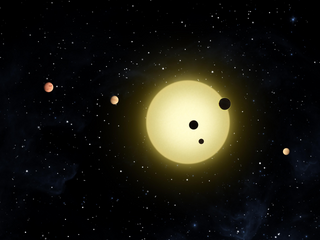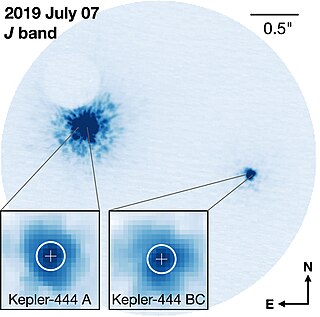Related Research Articles
Kepler-5 is a star located in the constellation Cygnus in the field of view of the Kepler Mission, a NASA project aimed at detecting planets in transit of, or passing in front of, their host stars as seen from Earth. One closely-orbiting, Jupiter-like planet, named Kepler-5b, has been detected around Kepler-5. Kepler-5's planet was one of the first five planets to be discovered by the Kepler spacecraft; its discovery was announced on January 4, 2010 at the 215th meeting of the American Astronomical Society after being verified by a variety of observatories. Kepler-5 is larger and more massive than the Sun, but has a similar metallicity, a major factor in planet formation.

Kepler-9 is a sunlike star in the constellation Lyra. Its planetary system, discovered by the Kepler Mission in 2010 was the first detected with the transit method found to contain multiple planets.

Kepler-11, also designated as 2MASS J19482762+4154328, is a Sun-like star slightly larger than the Sun in the constellation Cygnus, located some 2,110 light years from Earth. It is located within the field of vision of the Kepler spacecraft, the satellite that NASA's Kepler Mission uses to detect planets that may be transiting their stars. Announced on February 2, 2011, the star system is among the most compact and flattest systems yet discovered. It is the first discovered case of a star system with six transiting planets. All discovered planets are larger than Earth, with the larger ones being about Neptune's size.
Kepler-20 is a star about 934 light-years from Earth in the constellation Lyra with a system of at least five, and possibly six, known planets. The apparent magnitude of this star is 12.51, so it cannot be seen with the unaided eye. Viewing it requires a telescope with an aperture of 15 cm (6 in) or more. It is slightly smaller than the Sun, with 94% of the Sun's radius and about 91% of the Sun's mass. The effective temperature of the photosphere is slightly cooler than that of the Sun at 5466 K, giving it the characteristic yellow hue of a stellar class G8 star. The abundance of elements other than hydrogen or helium, what astronomers term the metallicity, is approximately the same as in the Sun. It may be older than the Sun, although the margin of error here is relatively large.
Kepler-36b is an exoplanet orbiting the star Kepler-36. This planet has the closest conjunction to Kepler-36c every 97 days. Its density is similar to that of iron.
Kepler-47 is a binary star system in the constellation Cygnus located about 3,420 light-years away from Earth. The stars have three exoplanets, all of which orbit both stars at the same time, making this a circumbinary system. The first two planets announced are designated Kepler-47b, and Kepler-47c, and the third, later discovery is Kepler-47d. Kepler-47 is the first circumbinary multi-planet system discovered by the Kepler mission. The outermost of the planets is a gas giant orbiting within the habitable zone of the stars. Because most stars are binary, the discovery that multi-planet systems can form in such a system has impacted previous theories of planetary formation.
Kepler-89 is a star with four confirmed planets. Kepler-89 is a possible wide binary star.
Kepler-65 is a subgiant star slightly more massive than the Sun and has at least four planets.

Kepler-90, also designated 2MASS J18574403+4918185, is a F-type star located about 2,790 light-years (855 pc) from Earth in the constellation of Draco. It is notable for possessing a planetary system that has the same number of observed planets as the Solar System.
Kepler-88 is a G-type star 1,230 light-years away in the constellation of Lyra, with three confirmed exoplanets. SIMBAD lists a subgiant spectral type of G8IV, while other sources give it a main sequence spectral type of G6V. The latter is more consistent with its properties.

Kepler-78 is a 12th magnitude star 407 light-years away in the constellation Cygnus. Initially classified as an eclipsing binary with orbital period 0.710015 days, it was later re-classified as a single star with significant interaction between star magnetosphere and close-in planet. The radius of the star is of about 74% of the Sun, and the effective temperature is about 5100 K.

Kepler-444 is a triple star system, estimated to be 11.2 billion years old, approximately 119 light-years (36 pc) away from Earth in the constellation Lyra. On 27 January 2015, the Kepler spacecraft is reported to have confirmed the detection of five sub-Earth-sized rocky exoplanets orbiting the main star. The star is a K-type main sequence star. All of the planets are far too close to their star to harbour life forms.
Kepler-1625 is a 14th-magnitude solar-mass star located in the constellation of Cygnus approximately 7,200 light-years away. Its mass is within 5% of that of the Sun, but its radius is approximately 70% larger reflecting its more evolved state. A candidate gas giant exoplanet was detected by the Kepler Mission around the star in 2015, which was later validated as a real planet to >99% confidence in 2016. In 2018, the Hunt for Exomoons with Kepler project reported evidence for a Neptune-sized exomoon around this planet, based on observations from NASA’s Kepler mission and the Hubble Space Telescope. Subsequently, the evidence for and reality of this exomoon candidate has been subject to debate.
Kepler-1625b is a super-Jupiter exoplanet orbiting the Sun-like star Kepler-1625 about 2,500 parsecs away in the constellation of Cygnus. The large gas giant is approximately the same radius as Jupiter, and orbits its star every 287.4 days. In 2017, hints of a Neptune-sized exomoon in orbit of the planet was found using photometric observations collected by the Kepler Mission. Further evidence for a Neptunian moon was found the following year using the Hubble Space Telescope, where two independent lines of evidence constrained the mass and radius to be Neptune-like. The mass-signature has been independently recovered by two other teams. However, the radius-signature was independently recovered by one of the teams but not the other. The original discovery team later showed that this latter study appears affected by systematic error sources that may influence their findings.

HD 179070, also known as Kepler-21, is a star with a closely orbiting exoplanet in the northern constellation of Lyra. At an apparent visual magnitude of 8.25 this was the brightest star observed by the Kepler spacecraft to host a validated planet until the discovery of an exoplanet orbiting HD 212657 in 2018. This system is located at a distance of 354 light-years from the Sun based on parallax measurements, but is drifting closer with a radial velocity of −18.2 km/s.
K2-32 is a G9-type main sequence star slightly smaller and less massive than the sun. Four confirmed transiting exoplanets are known to orbit this star. A study of atmospheric escape from the planet K2-32b caused by high-energy stellar irradiation indicates that the star has always been a very slow rotator.
Kepler-51 is a Sun-like star that is about 500 million years old. It is orbited by three super-puff planets—Kepler-51b, c, and d—which have the lowest known densities of any known exoplanet. The planets are similar in radius to gas giants like Jupiter, but have unusually small masses for their size, only a few times greater than Earth’s.
K2-24 is a metal-rich G3-type main sequence star larger and more massive than the Sun, located 560 light-years away in the constellation Scorpius. Two confirmed transiting exoplanets are known to orbit this star. An attempt to detect stellar companions using adaptive optics imaging at the Keck telescope was negative however later observations using lucky imaging at the Danish 1.54 m telescope at La Silla Observatory detected a possible companion at 3.8 arcseconds distance from K2-24. This candidate companion being over 8 magnitudes fainter than K2-24 and with a color temperature of 5400 Kelvin, is inconsistent with a bound main sequence companion.

Kepler-1638 is a G-type main-sequence star located about 5,000 light years away in the constellation of Cygnus. One known exoplanet has been found orbiting the star: Kepler-1638b.As of January 2021, Kepler-1638 is the farthest star with a known exoplanet orbiting in the habitable zone.
Kepler-167 is a K-type main-sequence star located about 1,119 light-years (343 pc) away from the Solar System in the constellation of Cygnus. The star has about 78% the mass and 75% the radius of the Sun, and a temperature of 4,884 K. It hosts a system of four known exoplanets. There is also a companion red dwarf star at a separation of about 700 AU, with an estimated orbital period of over 15,000 years.
References
- 1 2 3 4 5 Vallenari, A.; et al. (Gaia collaboration) (2023). "Gaia Data Release 3. Summary of the content and survey properties". Astronomy and Astrophysics. 674: A1. arXiv: 2208.00211 . Bibcode:2023A&A...674A...1G. doi: 10.1051/0004-6361/202243940 . S2CID 244398875. Gaia DR3 record for this source at VizieR.
- 1 2 3 4 5 6 7 8 9 Carter, J. A.; et al. (2012). "Kepler-36: A Pair of Planets with Neighboring Orbits and Dissimilar Densities". Science. 337 (6094): 556–559. arXiv: 1206.4718 . Bibcode:2012Sci...337..556C. doi:10.1126/science.1223269. PMID 22722249. S2CID 40245894.
- 1 2 Vissapragada, Shreyas; et al. (2020). "Diffuser-assisted Infrared Transit Photometry for Four Dynamically Interacting Kepler Systems". The Astronomical Journal. 159 (3). 108. arXiv: 1907.04445 . Bibcode:2020AJ....159..108V. doi: 10.3847/1538-3881/ab65c8 . S2CID 195874295.
- ↑ "Kepler-36". SIMBAD . Centre de données astronomiques de Strasbourg . Retrieved 2020-08-07.
- ↑ Bodenheimer, P.; Stevenson, D.; Lissauer, J.; D'Angelo, G. (2018). "New Formation Models for the Kepler-36 System". The Astrophysical Journal. 868 (2): id. 138 (17 pp.). arXiv: 1810.07160 . Bibcode:2018ApJ...868..138B. doi: 10.3847/1538-4357/aae928 . S2CID 59055335.


